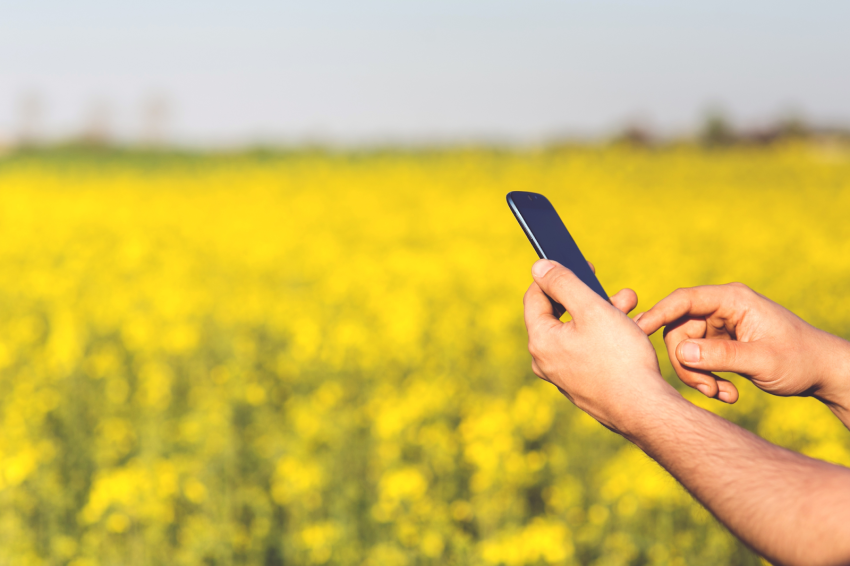In this information age, mobile apps are used to store and transform information in many forms such as voice, photos, video, and data from all over the world. Because of the interconnection of information, big sectors have come to rely on mobile apps to the point where conventional approaches are being superseded by current technological ones.
Agriculture, together with its linked sectors, contributes for almost 70% of India’s livelihood, with agriculture being the primary source of income for the majority of rural households. When used correctly, information technology can play an important role in all stages of farming. Mobile apps have the potential to alter the agriculture supply chain, from crop selection to final product disposal to the customer.
In this post, we will cover the importance of having a farming mobile app, specifically focusing on the benefits it provides to farmers. Additionally, we will discuss the outcomes that arise from these benefits, emphasizing the current state of mobile apps in this booming industry, particularly in the context of Mobile Application Development Service in Dubai.
Agriculture smartphone apps are required
Farmers are increasingly reliant on agriculture mobile apps. In rural India, the current market share of mobile-cellular devices is around 499 million users, with 109 million customers owning smartphones. Various mobile apps are directly and indirectly assisting persons involved in agriculture by increasing the overall functionality of the business.
Farmers are actively adopting smartphone apps for farming, from texting to emailing. The figures below represent numerous fields in which cellphones are actively employed.
Here are some statistics to assist you understand the demand for agricultural mobile apps:
- According to the Ministry of Labor and Employment labor bureau, India has over 200 million agricultural laborers who contribute more than 13.7 percent of GDP growth.
- Mobile apps have become a significant instrument for technology transfer, and the use of ICT tools in agriculture is emerging as a viable tool for enhancing farmers’ livelihoods.
- New farming practices and approaches can be easily learned through mobile learning or e-learning.
- Various smartphone apps can assist farmers in making informed decisions about seed selection, sowing, production strategies, and disease identification.
- Governments can directly work with farmers using mobile apps, giving them information on product sales, procurement, and government subsidies.
Not only mobile applications, but cloud, integrated IT systems, and Blockchain technologies, in conjunction with mobile app technologies, play a key role in disseminating agricultural-related information to farmers.
As a result, mobile apps can help farmers adopt better farming techniques and save money. We discussed farmers in general, but what about small-holder farmers, who face greater risks than farmers in general?
Also Read: Creating User-Centric Experiences: The Key to Effective Mobile App Development
Small-scale farmers and mobile app technology
In the midst of all of this, the position of small-holder farmers is sometimes forgotten. These farmers are far more vulnerable to agricultural risks, such as climate change. With lower profit margins, these farmers are frequently only farming to feed their dependents.
Small-holder farmers require low-cost techniques to succeed. Recent improvements in Internet and cell phone technologies (ICT) bring in a lot of fantastic chances and leap over the expensive technology that small-holder farmers often cannot afford.
Farmers can benefit from improved connectivity and information flow by utilizing existing tools and technologies. However, the industry’s major sharks have the power and resources to harness these technologies. However, in the past, this was only done in response to government pressure.
As a result, mobile apps and ICT technologies benefit small-holder farmers as well. In the following section, you will learn about the outcomes obtained through mobile application development services for the farming community.
Outcomes Produced by Mobile Apps for the Farming Community
1. Having timely access to relevant information
Mobile apps enable easy access to market prices, current mandi rates, irrigation management, fertilizer dose, field preparation, technical breakthroughs, and disease information. Farmers can organize their operations and take precautionary precautions with the help of these methods.
2. Availability of extension services
Mobile-based technology has accelerated the delivery of extension services. These technologies are critical for driving innovation and development in lab-to-field measurements. These government-developed procedures and approaches are reaching farmers, resulting in high yield production through two-way communication via diverse mobile application development.
3. The connection between the direct market and the distribution network
Farmers can get information about real-time mandi prices via mobile apps, resulting in higher prices and profits for farmers. These apps allow farmers, suppliers, and customers to communicate directly with one another.
4. Accountability and traceability
Farmers have advanced due to increased efficiency and predictability, lower administrative expenses, and less exploitation by middlemen, which has improved quality standards for purchasers and reduced fraud.
5. Access to financial resources
Farmers are being empowered by mobile app technologies that make financial industry services available on their smartphone devices, such as information regarding government aid to farmers and various rebates on farm equipment.
Also Read: Building the Future of the Internet: Empower Your Business with a Web3 Development Company
The Last Wise Words
The use of mobile app technology has made agriculture more appealing to farmers in underdeveloped nations and small-holding farmers in general. Reduced transportation and transactional and illicit trade waste are the overriding benefits of ICT in agriculture. It not only simplifies agriculture for farmers, but it also provides product traceability, disease tracking, and storage.
The agriculture market is in desperate need of disruption, and if you’re seeking the best software engineers to assist you, we’ve got you covered!




